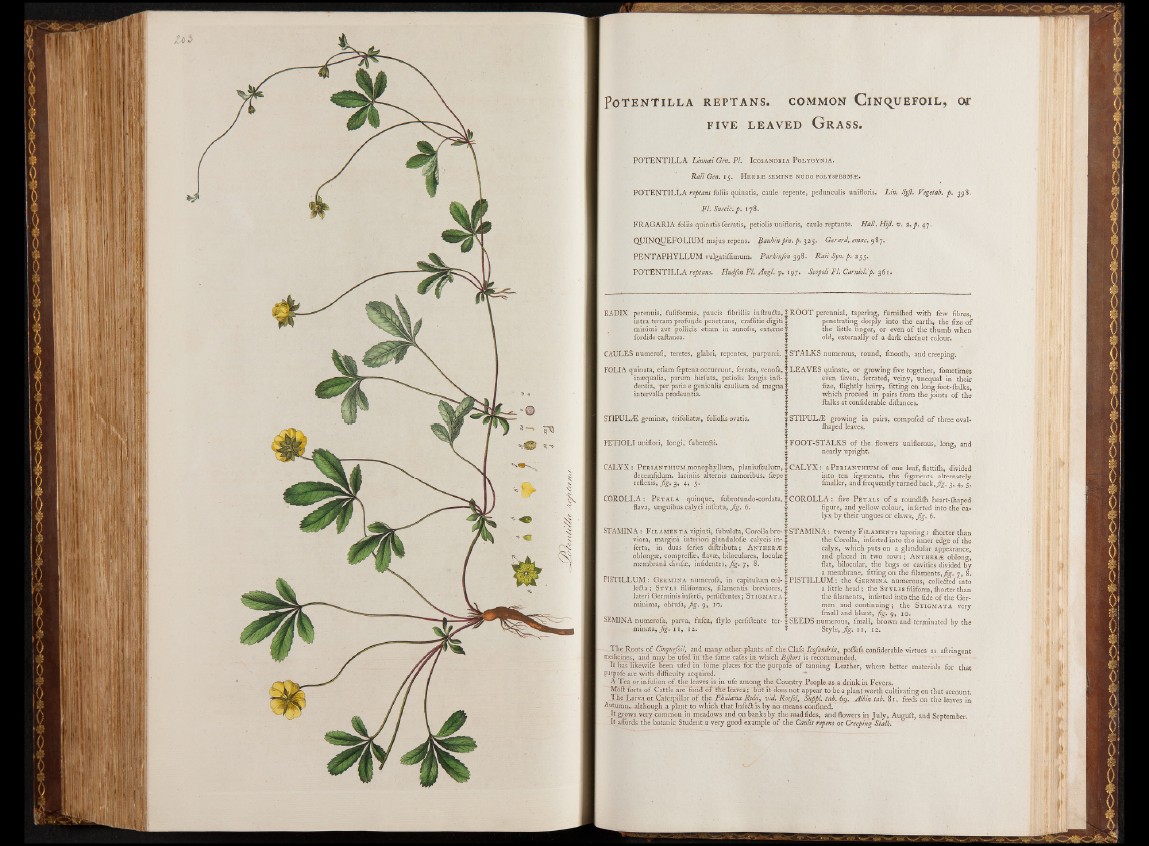
POTENTILLA REPTANS. COMMON ClN^UEFOIL, Of
FIVE LEAVED GRASS.
POTENTILLA Linnai Gen. PI. IcosAndria Polygynia.
Rail Gen. 15. Herby semine nudo polyspermy.
POTENTILLA reptans foliis quinatis, caüle repen te, pedunculis unifloris. Lin. Sjfi. Feget ab. p. 398.
Fl. Suecic. p. I 78.
FRAGARIA foliis quinatis ferratis, petiolis unifloris, caule reptante. Hall. Hiß. v. 2. p. 47.
QUINQUEFOLIUM majus repens. Jiauhinpin. p. 325. Gerard, emac. ^87.
PENTAPHYLLUM vulgatiflimura. Parkinfin 398. Raii Syn. p> 255.
POTENTILLA reptans. Hudfon Fl. Angl. p. 197. Scopoli FI. Carniol.'p. 361.
RADIX perennis, fufiformis, paucis fibrillis inftru&a, | ROOT perennial, tapering, furnilhed with few fibres,
intra~terram profunde penetrans, craffitie digiti | penetrating deeply into the earth, the fize of
aut p0nicls etiam in.annofis, externe| the little finger, or even of the thumb when
| old, externally of a dark chefnut colour.
wHm ■
GAULES numerofi, teretes, glabri, repentes, purpurei. | STALKS numerous, round, fmooth, and creeping.
FOLIA quinata, etiam fepten'a occurrunt, ferrata, venofa, | LEAVES quinate, or growing five together, fometimes
inasqualia, parum hirfuta, petiolis longis infi-| even feven, (errated, veiny, unequal in their
dentia, per paria e geniculis caulium ad magna | fize, (lightly hairy, fitting on long foot-ftalks,
| which proceed in pairs from the joihts of the
I (talks at confiderable diftances.
STIPUL^E geminas, trifoliate, foliolis ovatis. | STIPULE growing in pairs, compofed of three oval-
| (haped leaves.
iI
FOOT-STALKS of the, flowers uniflorous, long, and
| nearly upright.
I .
CALYX: PERiANTHiuMmonophyllum, planiufculum, | C A L Y X : 3Perianthium of one leaf, flattilh, divided
decemfldum, laciniis alternis minoribus, (ape? into ten fegments, the (egments alternately
„ reflexis, Jig. 3, 4, 5. | fmaller, and frequently turned back, jig-. 3 ,4 ,5.
COROLLA: Petal a quinque, fubrotundo-cordata, | COROLLA: five Petals of a roundifh heart-(haped
flava, unguibus calyci inferta, Jig. 6. f figure, and yellow colour, inferted into the ca-
' ' . t . . . .
t
lyx by their ungues or claws, fig. 6.
STAMINA : F ilamenta viginti, fubulata, Corolla bre-J STAMINA: twenty F ilaments tapering: (horter than
viora, margini interiori glandulofa calycis in-1 the Corolla, inferted into the inner edge of the
- ferta, in duas feries diftributa; Anther j e j calyx, which puts on a glandular appearance,
" oblongas, compreflfe, (lavas, biloculares, loculaei and placed in two rows; A nther je oblong,
membranè divifie, infidentes, fig. 7, 8. $ flat, bilocular, the bags or cavities divided-by
*'1 . ' I a membrane, fitting on the filaments, jig. 7, 8.
PISTILLUM: Germina numerofa, in capitulum ool-1 P ISTILLUM: the Germina numerous, colle&ed into
lefta; St y li filiformes, filamentis breviores, ? a little head; the Styles filiform, (horter than
lateri Germinis inferti, perfiftentes; Stigmata | thé filaments, inferted into the fide of the Germinima,
obtufa, fig. 9, 10. | men and continuing; the Stigmata very
' J p^ r'-V ■ ‘ . v ' ♦ fmall and blunt, fig. 9, 10. •
SEMINA numerofa, parva, fufca, ftylo perfiftente ter-1 SEEDS numerous, fmall, brown and terminated by the
“ :~ata, fig. 1 1, 12. ? Style, fig. 11, 12.
-The Roots of Cinquefoil, and many otlier plants.of.rhe. Clafs Icofandria, pofTefs confiderable virtues as aftringent
medicines, and may be ufed iii the fame cafes in which Biftort is recommended.
It Has filcewife been ufed in (orhe places for the purpofe of tanning Leather, where better materials for that
purpofe are with difficulty acquired.
A Tea or infufion of the leaves is in ufe among the Country People as a drink in Fevers.
'Mbft forts of Cattle are fond óf thé leaves; but it does not appear to be a plant worth cultivating on that account.
ThëXafva or Caterpillar of the Phaleena Rubi, vid. Roejel, Suppl. tab. 69. Albin tab. 81. feeds on the leaves in
Autumn, although a plant to which that Infeftisby no means confined.
h grows Very common in meadows and on banks by the roadTides, and flowers in July, Auguft, and September.
It affords the botanic Student a very good example of the Caulis repens or Creeping Stalk.